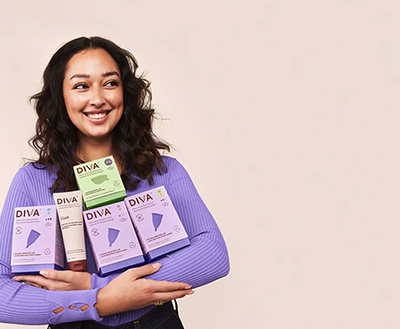
In this article /

First of all, thanks to the wonderful staff at the DivaCup for allowing me to guest blog this week! The DivaCup is a fabulous way for women to measure and cope with their flow. Thanks again!
Now on to the topic at hand …
The curse. Aunt Flo. Big Red. Whatever you call it, bleeding once a month is what we do as people who menstruate, whether we like it or not.
For some of us, menstruation is nothing more than an annoying, inconvenient, sometimes painful reminder of our potential to make a baby, while for others, like me, and millions of other women around the world, menstruation was, or is, a bloody nightmare that can lead to heavy, or abnormal, uterine bleeding.
- Imagine wearing an adult diaper, a superplus tampon and an overnight pad while chairing an executive board meeting.
- Imagine meeting your future husband’s best friends for the first time and leaving a red stain on their expensive white chair when you stand up to leave.
- Imagine sleeping on an air mattress on your bedroom floor three nights each month to avoid leaking blood all over your mattress.
- Imagine leaking blood into your shoes when you stand up to greet a new client for the first time.
- Imagine being told your life could be in danger if you have one more period like the one you had the month before.
These are not fictitious accounts created for dramatic effect or to capture attention; they are true stories I experienced myself, or heard from women who spoke with me for my book, The UnHysterectomy: Solving Your Painful, Heavy Bleeding Without Major Surgery.

What amazes me most about the stories women have shared with me is that every one of them, without exception, thought their pain and bleeding was normal, something they “just had to put up with.”
Some suffered for as long as seven to 10 years without seeking treatment, or were told by their doctors and gynecologists that it was “all in their head”.
Here’s a news flash, gals – it’s not normal to bleed that much!
Heavy menstrual bleeding, now a medically-accepted clinical term under new treatment guidelines published by the Canadian Society of Obstetricians and Gynecologists (SOGC) and the American College of Obstetricians and Gynecologists (ACOG), is “the direct cause of a significant health care burden to women, their families and society as a whole” affecting up to 30 percent of women of reproductive age.
In Canada, heavy menstrual bleeding is now defined as “excessive menstrual blood loss which interferes with the woman’s physical, social, emotional and/or material quality of life … [that] can occur alone or in combination with other symptoms.”
What can influence our periods?
- Hormones
- Stress
- Being overweight or underweight
- Exercising too much
- Certain medications and
- Certain health conditions
What causes heavy menstrual bleeding?
With the exception of certain conditions such as ovarian, uterine or cervical cancer, which can produce abnormal uterine bleeding even after menopause, most heavy menstrual bleeding can be attributed to other, more benign conditions such as:
- Fibroids (non-cancerous tumours, what I had). Fibroids account for more hysterectomies in Canada than any other disease.
- Adenomyosis (thickening of the uterus)
- Endometriosis (where uterine tissue grows outside the uterus)
- Polyps (benign masses)
- Cysts
- Polycystic ovary disease
- Uterine hyperplasia (when the lining of the uterus becomes too thick) and
- von Willebrand disease
Signs and Symptoms
No two women menstruate alike so it’s very difficult to quantify exactly what constitutes heavy menstrual bleeding. The SOGC has published definitions on page S6 of its new guidelines, published in the May issue of the Journal of Obstetrics and Gynecology.
Generally speaking, however, here are some signs and symptoms of heavy menstrual bleeding to watch for:
- Having to change your pad or tampon every hour or filling a menstrual cup every 2-3 hours.
- Soaking through your bedclothes, pyjamas, clothing or upholstery
- Spending more than usual amounts of money on supplies every month
- Passing clots
- Gushing blood upon standing
- Changing your social or work schedule to accommodate your period
- A feeling of fullness in your belly
- Anemia
- Chronic fatigue
- Difficulty concentrating or understanding things
- Bleeding past menopause (if this is the case, you MUST see your doctor IMMEDIATELY)
Treatments
In 2013, thanks to an explosion in high technology and medical breakthroughs in new diagnostics and drug therapies, women suffering from heavy menstrual bleeding have a full range of treatment options that do not necessarily end in hysterectomy.
From least invasive to most invasive, some of the treatment options are:
- Watchful waiting
- Birth control
- Hormone therapy
- Surgery, including myomectomy, endometrial ablation, uterine artery embolization (difficult to find in Canada) and focused ultrasound (starting to become more available thanks to trials being conducted at Sunnybrook Hospital in Toronto)
- Hysterectomy
Choose Wisely
Not every gynecologist will tell you the full range of treatment options available (nor are they familiar with all of them) as I discovered first-hand in my own journey, and through multiple interviews I conducted for my book.
As women, we sometimes need to advocate for ourselves and shop around until we find a physician who can offer us the treatment options that WE want, not the ones THEY are willing to perform.
Unfortunately there are physicians in this country who are not fully aware of all the treatment options, or simply do not know how to perform less invasive procedures.
Ask and you shall receive.
I can’t tell you the number of women who have read my book and are being empowered with new knowledge were able to advocate for better menstrual care at their doctor visits. It was very empowering for them and very rewarding for me.
Final Thoughts
If you suspect you have heavy menstrual bleeding, pick up the phone right now and call your family doctor for your first appointment, or go direct to a gynecologist if you live in the U.S. where referrals from family doctors are unnecessary.
- Early diagnosis is key
- Stop telling yourself all that blood is normal
As I also say in my book, a fabulous way to measure your flow is to use a device like The DivaCup to measure how much blood you’re losing on a daily basis.
Want to get pregnant?
My absolute closing thought is devoted to those younger women who want to solve their heavy menstrual bleeding, but still want to get pregnant. Please know that some of the treatments I have mentioned, such as ablations, are only for women who are past having children.
Having said this, there are many other treatments that can remove your fibroids while preserving your fertility and you simply MUST ask about them before agreeing to any major surgery.
Disclaimer: The information and opinions expressed herein are not a substitute for the advice of a physician. Only your doctor or a qualified health provider can provide you with advice and recommendations for your situation. This post and the book, The UnHysterectomy: Solving Your Painful, Heavy Bleeding Without Major Surgery. presents information that has been researched and written by a patient for patients. Some of the testimonials contained within the book are composites to protect the privacy of those interviewed. Medical experts have reviewed the medical information for accuracy; however, the information provided should not be used as the sole source of information regarding hysterectomy and its alternatives. Every attempt has been made to present a balanced account of this issue. Any errors or omissions are unintentional. Holly Bridges, her heirs, administrators, successors, agents and assigns, cannot be held liable for injury or damages resulting from use of the information provided in this blog post and the referred to publication.
























